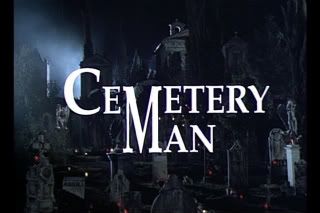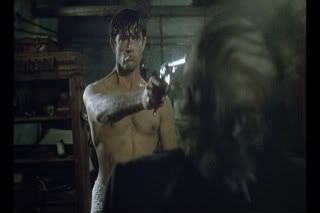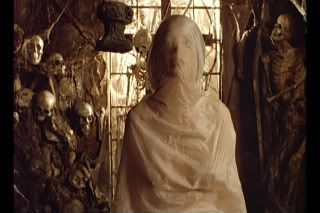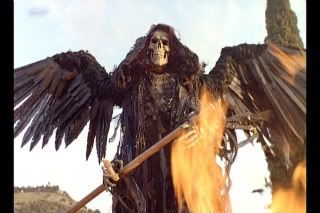Part of the oddly popular "stripper vs zombie" sub-genre (which also includes Zombie Strippers! (2008) and Zombies! Zombies! Zombies! (2008)), Kyonyû doragon: Onsen zonbi vs sutorippâ 5 - also known by a multitude of increasingly offensive titles - may originate from the manga Kyonyū Dragon by Rei Mikamoto, but it's obviously heavily influenced by the recent slate of ultra-violent low-budget Japanese exploitation films like Machine Girl and Tokyo Gore Police, as well as Quentin Tarantino's Grindhouse and Kill Bill whose attempts at a modern exploitation rebirth are echoed in the spaghetti western references of the soundtrack, and in its deliberately aged and scratched opening credits. With a title like this you probably know what you're in for, and thankfully director Takano Nakano (who also helmed the wonderfully titled Sexual Parasite: Killer Pussy (2004)) seems to feel obligated to deliver the goods.
We begin with a grammatically iffy lift of the title card from Sergio Leone's For a Few Dollars More, and you could be excused for beginning to grow concerned about the quality control already on display. Thankfully such concerns are pushed to the wayside as we're thrown into an immediate bloody fray between the chainsaw wielding Lena Jodo (Japanese AV star Sola Aoi) and a hoard of zombies of surprisingly varying quality. We very quickly get an idea of what we're going to be in for over the next 73 minutes - lots of CG-assisted splatter and flying limbs in the mold of Troma films, and with a winking sense of humor lest you get concerned that a film also known as Big Tit Zombies might get a bit too dark.
The plot follows Lena - newly arrived back in Japan after a booze-fueled trip through Mexico (she carries a sombrero and some obvious Spaghetti Western undertones) - as she gets a job stripping at the Paradise Ikagawa Theater, along with former criminal Ginko (AV star Risa Kasumi), Gothic Lolita Maria (Gravure idol Mari Sakurai), money obsessed Dana (Io Aikawa) and the older Nene (Tamayo). After a temporary closing due to lack of business, the five find themselves incredibly bored and begin working at a local Spa to make some extra money. Thankfully they manage to find a secret door in the dressing room which leads to a room that includes both a Well of Spirits and a Necronomicon, which Maria (who is constantly quoting Shakespeare and Rochefoucauld) wastes no time in using to bring the dead to life. These are the shuffling, bite-one-and-you-become-one type of zombies, and soon the town is overrun.
Dana gets eaten rather quickly, but while Lena, Ginko and a newly bitten Nene attempt to escape, Maria gleefully accepts life as a zombie queen. We soon discover that Ginko holds a horrible secret involving her time in prison, while Nene develops a fire-spouting vagina - quelled by a quick gun blast to the head. Lena and Ginko decide to seal up the Well of Spirits, but they'll have to contend with Maria, the puppet head of zombie Dana (simultaneously both the film's worst and most enjoyable effect) and a slew of zombies. Oh, and as expected they lose their tops a couple of times each as well.
It might be excessive to mention that the film's proceedings take place with tongue pressed firmly through cheek, but I was actually impressed with some of the sharp writing on display - particularly in Maria's ridiculous Lolita character who takes time to explain the political themes of Romero's Night of the Living Dead, and refers to a severed hand as an "ultimate wrist slitting" (Maria is earlier shown to be a cutter, and her Goth love is a constant source of amusement). There are purely bizarre moments: zombie sushi, eyeball ping-pong, battling an extended zombie tongue with wasabi paste, but they all contribute to the unhinged, anything-can-happen atmosphere.
While slow to get going - at least after the opening scene which nearly repeats in full at the film's end - the pace builds nicely to an impressive final half hour, even as the quality of the special effects starts to get a bit sketchy. Visual effects are by Tsuyoshi Kazuno, who also worked on Machine Girl, RoboGeisha, and similar projects, and if you've seen the copious ridiculous visual effects in those films you probably know what to expect. As a director Nakano is inconsistent, though he's obviously willing to accept his limitations and manages to fit in a few moody shots when he's not zooming into his cast's cleavage. This is obviously quick and dirty filmmaking, though has a similar anarchic spirit to earlier film's like the Guitar Wolf starring Wild Zero.
Acting awards go to Sola Aoi in the lead - she brings a lot of charisma and energy to a role that demands it - and Mari Sakurai who brings a fun twist to the villain role. Risa Kasumi is attractive, but is a bland performer and looks uncomfortable and stiff during her action scenes. She's also saddled with the only thing resembling drama in the film, but unfortunately doesn't exude the toughness needed for the role. Watch out for comedian Minoru Torihada who pops up briefly at the film's end.
I should mention that this film was also released in a 3D version, though I've read only a handful of short sequences that take advantage of the format - with a countdown that appears on the screen when necessary. I doubt you'll be missing much watching this in 2D, but if you want to get the full Big Tits Dragon experience you'll need to pony up for that edition.


































